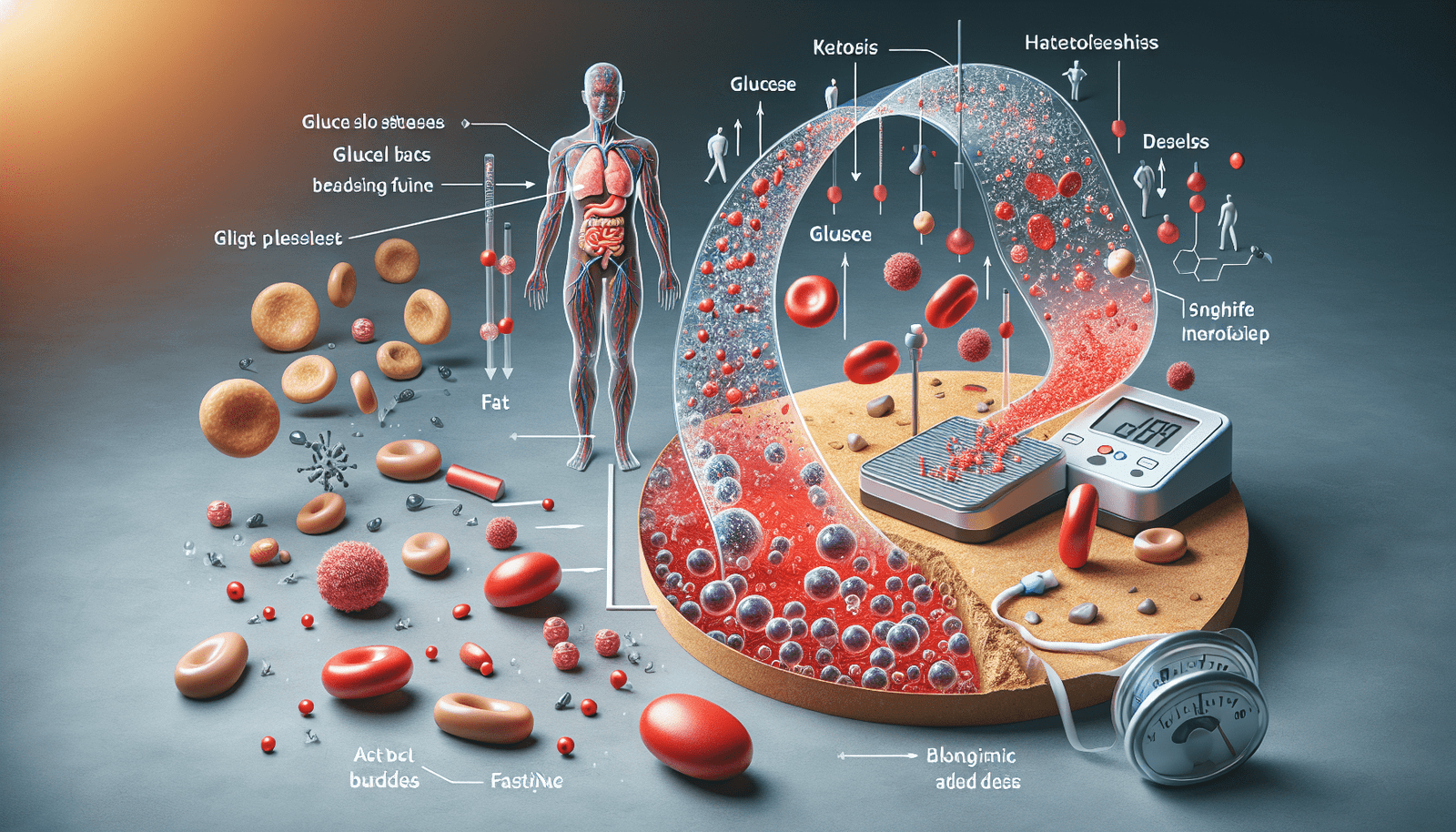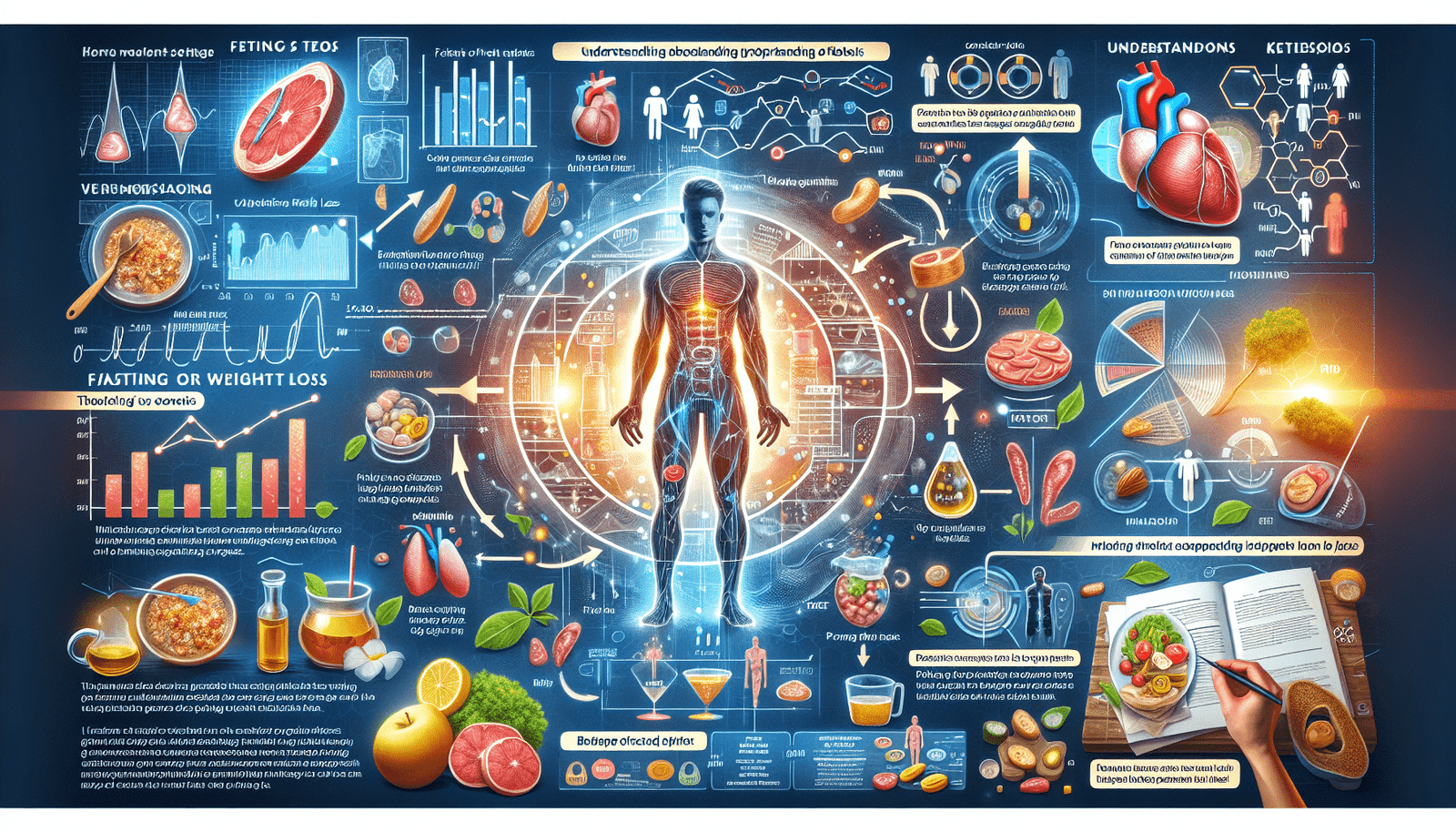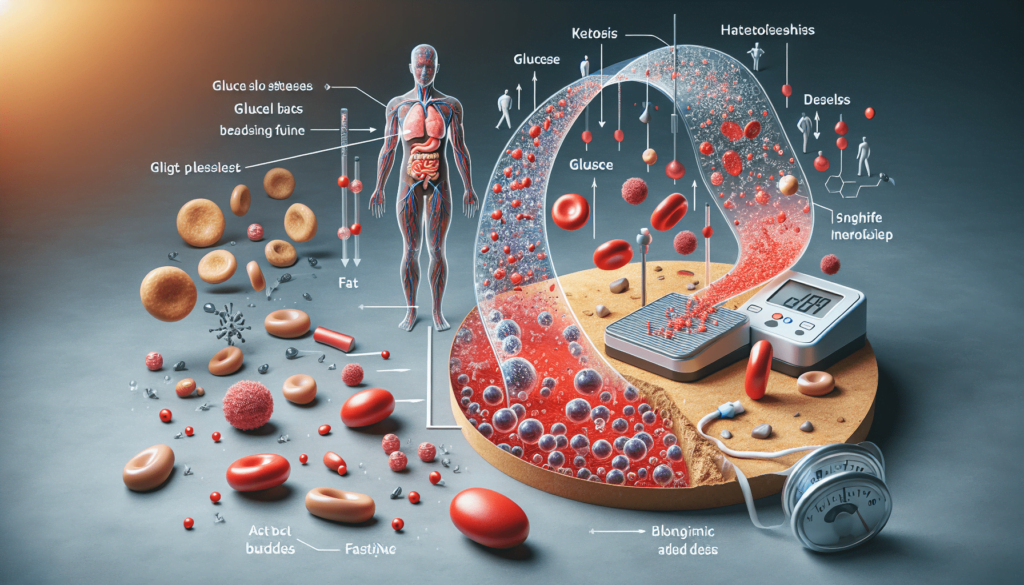So you’re looking to shed some extra pounds and you’ve heard about this thing called fasting. But what exactly is fasting all about? In this article, we’ll take a closer look at fasting for weight loss and specifically dive into a process called ketosis. You’ll learn how fasting can tap into your body’s fat stores and help you reach your weight loss goals. So sit back, relax, and get ready to discover the key to losing weight through fasting and understanding ketosis.
Introduction to Fasting for Weight Loss
Fasting has become increasingly popular as a weight loss tool in recent years. Many people are drawn to this approach because it offers a way to shed pounds without requiring strict dieting or intense exercise routines. By strategically timing periods of eating and fasting, you can tap into the potential benefits of fasting for weight loss. In this article, we will explore the different types of fasting, how fasting promotes weight loss, and the concept of ketosis, which plays a crucial role in this process.
Definition of Fasting
Fasting refers to the intentional abstinence from consuming food or drinks for a specific period of time. While some people may associate fasting with religious or spiritual practices, it has gained attention in the wellness and weight loss communities as a means to achieve specific health goals. The duration of a fast can range from just a few hours to several days, depending on the chosen fasting protocol.
Benefits of Fasting for Weight Loss
Beyond its potential for weight loss, fasting offers a range of benefits for overall health and well-being. One of the primary advantages is its ability to promote autophagy, a cellular recycling process that helps remove damaged cells and tissues. This can help optimize your body’s functioning and potentially reduce the risk of certain diseases. Fasting also appears to have positive effects on insulin sensitivity, inflammation, and even cognitive function.

Understanding the Concept of Ketosis
To truly grasp the role of fasting in weight loss, it’s essential to understand the concept of ketosis. Ketosis is a metabolic state in which your body primarily relies on fat as its fuel source instead of carbohydrates (glucose). This shift occurs when your body’s glycogen stores are depleted, and it begins breaking down fats into ketone bodies for energy. Ketosis not only supports weight loss by increasing fat burning but also offers numerous other health benefits, such as improved brain function and reduced inflammation.
Different Types of Fasting
There are several types of fasting that you can incorporate into your weight loss journey. Each approach has its own unique characteristics and advantages, allowing you to choose one that aligns with your lifestyle and preferences.
Intermittent Fasting
Intermittent fasting involves alternating periods of eating and fasting. The most popular methods include the 16/8 method, which involves fasting for 16 hours and consuming all meals within an 8-hour window, and the 5:2 method, which allows for normal eating five days a week and restricting caloric intake to 500-600 calories on two non-consecutive days.
Extended Fasting
Extended fasting typically lasts longer than 24 hours and can range from a few days to several weeks, depending on personal goals and medical considerations. This type of fasting requires careful planning and supervision to ensure adequate nutrient intake and to minimize potential risks.
Time-Restricted Feeding
Time-restricted feeding is a type of fasting that involves consuming all meals within a specific window of time each day. This approach typically involves a fasting period of 12-16 hours and an eating window of 8-12 hours. By condensing your meals into a shorter timeframe, you give your body an extended period of rest from digestion, which may have various health benefits.
How Fasting Promotes Weight Loss
Fasting promotes weight loss through several mechanisms, all of which work together to create a calorie deficit and facilitate fat burning. Let’s explore these mechanisms in more detail.
Caloric Restriction
Fasting inherently restricts the number of calories consumed within a given period. By limiting your eating window or abstaining from food entirely, you naturally reduce your overall caloric intake, leading to weight loss.
Increased Fat Burning
In the absence of readily available glucose, your body turns to stored fat as its primary fuel source. This metabolic shift during fasting enables increased fat burning, which directly contributes to weight loss.
Reduced Insulin Levels
Fasting lowers insulin levels, allowing your body to tap into stored fat more easily. Insulin is a hormone that regulates blood sugar levels and promotes fat storage. By reducing insulin secretion, fasting helps unlock stored fat for energy and promotes weight loss.
Regulation of Hunger Hormones
Fasting has been shown to influence the levels of certain hunger hormones, such as ghrelin and leptin. Ghrelin, often referred to as the “hunger hormone,” increases appetite, while leptin helps regulate feelings of fullness. By moderating these hormones, fasting can help control appetite and prevent overeating.
Metabolic Benefits
Fasting has a positive impact on your metabolic health, as it can improve insulin sensitivity, reduce inflammation, and enhance mitochondrial function. These changes are beneficial for overall weight management and contribute to the long-term success of fasting for weight loss.

Understanding Ketosis
Ketosis is a metabolic state that occurs when the body relies predominantly on fat for fuel. In this state, ketones, which are byproducts of fat metabolism, become the primary energy source for cells throughout the body. Understanding the basics of ketosis is crucial for anyone considering fasting as a weight loss strategy.
Definition of Ketosis
Ketosis is a natural physiological state in which the body produces ketone bodies from fat breakdown. These ketone bodies serve as an alternative energy source when glucose availability is limited.
How Ketosis is Achieved During Fasting
When you fast, your body undergoes a series of metabolic changes to adapt to the absence of food. Initially, it depletes its glycogen stores, which are the stored form of glucose. Once glycogen stores are depleted, your body begins breaking down fats to produce ketone bodies. This transition typically occurs within 24 to 48 hours of fasting.
Benefits of Ketosis for Weight Loss
Achieving ketosis while fasting has several benefits for weight loss. As mentioned earlier, ketosis enhances fat burning, and this, in turn, can contribute to weight loss. Additionally, being in ketosis can help manage appetite, stabilize blood sugar levels, and promote satiety, all of which are essential aspects of successful weight management.
Health Considerations When in Ketosis
While ketosis is generally safe for most healthy individuals, there are some considerations to keep in mind. Ketones can acidify the blood, potentially leading to a state called ketoacidosis, which is a medical emergency. However, this is primarily a concern for individuals with diabetes or certain medical conditions. It’s also essential to maintain proper hydration and electrolyte balance while in ketosis.
Common Misconceptions About Ketosis
One common misconception about ketosis is that it is synonymous with ketoacidosis, a dangerous condition primarily associated with uncontrolled diabetes. It is crucial to distinguish between nutritional ketosis, which is a safe and controlled state achieved through diet, and diabetic ketoacidosis, a serious medical emergency.
The Science Behind Ketosis
To truly understand ketosis, it’s important to explore the underlying science of how the body metabolizes carbohydrates and fats, as well as the role of insulin in this process.
Carbohydrate Metabolism
When you consume carbohydrates, they are broken down into glucose, which is then utilized as a primary energy source. Excess glucose is stored as glycogen in the liver and muscles.
Fat Metabolism
During fasting or carbohydrate restriction, the body turns to its fat stores for energy. Stored fats are broken down into fatty acids, which then undergo a process called beta-oxidation, producing energy-rich molecules called ATP.
Production of Ketone Bodies
As fatty acids are broken down, the liver produces ketone bodies as an alternative fuel source. These ketone bodies include acetoacetate, beta-hydroxybutyrate, and acetone. They are transported via the bloodstream to various tissues for energy production.
Role of Insulin
Insulin is released by the pancreas in response to elevated blood glucose levels. It facilitates the storage of glucose as glycogen and inhibits the breakdown of stored fats. In the absence of insulin or when insulin levels are low, fat metabolism is upregulated, leading to ketone production.
Transitioning into Ketosis
Transitioning into ketosis can take several days, as your body needs time to deplete its glycogen stores and adapt to using ketones for energy. This is why fasting or following a low-carbohydrate, high-fat (LCHF) diet is often recommended to induce ketosis more efficiently.
Effects of Ketosis on Weight Loss
Entering a state of ketosis while fasting or following a ketogenic diet has several notable effects on weight loss and body composition.
Increased Fat Oxidation
Ketosis promotes increased fat oxidation, meaning that your body becomes more efficient at burning stored fat for energy. This can lead to significant weight loss, particularly in individuals with higher body fat percentages.
Preservation of Lean Muscle Mass
Unlike some traditional dieting approaches, ketosis helps preserve lean muscle mass during weight loss. This is crucial for maintaining a healthy metabolism, as muscle tissue requires more energy to sustain than fat tissue.
Appetite Suppression
Ketosis naturally suppresses appetite due to the satiating effects of ketones and the stabilization of blood sugar levels. This can help control food cravings and reduce overall caloric intake, further facilitating weight loss.
Enhanced Metabolic Rate
Ketosis has been found to increase metabolic rate in some individuals, which means you may burn more calories even at rest. This effect can contribute to more efficient weight loss and better long-term weight management.
Improved Insulin Sensitivity
Being in ketosis can improve insulin sensitivity, allowing your body to better regulate blood sugar levels. Improved insulin sensitivity is beneficial for weight loss and may reduce the risk of developing type 2 diabetes.
Implementing a Ketogenic Diet
To achieve and maintain ketosis, many individuals turn to a ketogenic diet. Here are some key components to consider when implementing a ketogenic diet for weight loss.
Food Choices for a Ketogenic Diet
A ketogenic diet focuses on high-fat, moderate-protein, and low-carbohydrate food choices. Healthy fat sources include avocados, nuts and seeds, olive oil, and fatty fish. Protein sources should be lean and include options like chicken, beef, and tofu.
Macronutrient Ratios
To achieve ketosis, the macronutrient ratios in a ketogenic diet typically consist of approximately 70-75% of calories from fat, 20-25% from protein, and only 5-10% from carbohydrates. These ratios can be adjusted slightly based on individual needs and tolerances.
Meal Planning and Preparation
Meal planning is a helpful strategy when following a ketogenic diet. Planning meals in advance ensures that you meet your macro and micronutrient needs while staying within the parameters of the diet. Preparing meals in bulk can also save time and make sticking to your nutritional goals more manageable.
Monitoring Ketone Levels
To confirm if you are in a state of ketosis, you can monitor your ketone levels using blood, urine, or breath tests. These tests indicate the presence and quantity of ketone bodies in your body, helping you gauge your progress and make any necessary adjustments to your diet or fasting protocol.
Potential Side Effects
As with any dietary change, there can be potential side effects when implementing a ketogenic diet. These can include the “keto flu,” which is a temporary set of symptoms that some individuals experience during the initial transition into ketosis. These symptoms can include fatigue, headaches, increased thirst, and nausea. It’s essential to stay well-hydrated, ensure adequate electrolyte intake, and consult with a healthcare professional if you have any concerns.
Combining Fasting and Ketosis
Combining fasting with a ketogenic diet can amplify the benefits of both approaches and support more effective weight loss. Here’s how various fasting protocols can be combined with a ketogenic diet.
Intermittent Fasting and Keto
Intermittent fasting can be easily integrated with a ketogenic diet by adopting an eating window that aligns with your dietary needs. For example, you can follow the 16/8 method, where you fast for 16 hours and consume all your meals within an 8-hour window. This allows you to maintain ketosis while also experiencing the potential benefits of intermittent fasting.
Extended Fasting and Ketosis
Extended fasting, lasting more than 24 hours, can induce ketosis effectively. Combining extended fasting with a ketogenic diet can promote rapid weight loss and increased fat burning. However, extended fasting should only be undertaken under medical supervision and is not recommended for everyone.
Time-Restricted Feeding and Ketosis
Time-restricted feeding, with its defined eating and fasting windows, can effortlessly complement a ketogenic diet. By ensuring that your eating window aligns with your macronutrient goals, you can optimize your chances of achieving and maintaining ketosis.
Optimal Fasting and Feeding Windows
Finding the optimal fasting and feeding windows can be a personal process, as it depends on individual lifestyle and preferences. Experimentation is key to determine what works best for you in terms of adherence, satiety, and results. It’s essential to listen to your body and make adjustments as needed.
Considerations and Precautions
While fasting and ketosis can be effective tools for weight loss, it’s essential to approach them with a personalized and cautious mindset. Consider the following factors to ensure the safety and efficacy of your weight loss journey.
Consulting a Healthcare Professional
Before embarking on any fasting or ketogenic diet, it’s essential to consult with a healthcare professional, particularly if you have underlying medical conditions or are taking medications. They can provide guidance tailored to your specific needs and help you navigate potential risks.
Individual Differences and Metabolic Health
Individual responses to fasting and ketosis can vary depending on factors such as age, sex, genetics, and pre-existing medical conditions. It’s crucial to be aware of your body’s unique requirements and adjust your approach accordingly.
Monitoring Nutrient Intake
While fasting or following a ketogenic diet, it’s important to pay attention to your nutrient intake to ensure you’re meeting your vitamin, mineral, and macronutrient needs. This can be achieved through conscientious meal planning and potentially considering supplementation if needed.
Minimizing Potential Risks
Prolonged fasting or extreme dietary restrictions can carry potential risks, especially for certain individuals. It’s essential to prioritize your health and well-being by practicing moderation, maintaining hydration, and seeking medical advice if you experience any adverse effects.
Adapting Fasting and Ketosis for Long-Term Sustainability
Fasting and ketosis should not be viewed as quick-fix solutions, but rather as tools to support sustainable weight loss and overall health. To ensure long-term success, it’s important to develop a personalized approach that encompasses balanced nutrition, regular physical activity, and a supportive environment.
Conclusion
Fasting, coupled with the metabolic state of ketosis, presents a promising strategy for weight loss and improved overall health. By understanding the science behind fasting, ketosis, and their effects on the body, you can confidently embrace this approach with personalized adjustments and precautions. Remember, sustainable lifestyle changes and a holistic mindset are key to achieving and maintaining your weight loss goals. So, embark on this journey with patience, self-compassion, and a commitment to long-term well-being.








